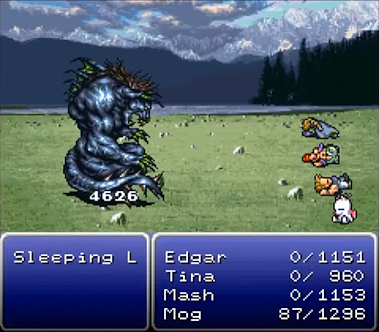Innovation of the Week: Risk/Reward
By alianger 1 Comments
Risk/reward or risk vs reward can be defined as a main ingredient in games, in that you tend to have to take a risk to overcome an obstacle in the first place, such as getting in the enemy's line of sight/attack range to be able to shoot it or hit it, or stronger blows being harder to land. Without this tension, there's no excitement and no fun, so it's a necessary ingredient for action games especially. It can also be translated to a turn-based game, for example when you make a dice roll for a speech check in an RPG as you're trying to convince an NPC to help you, but failing could turn them hostile. For this post, I'm focusing on where it's used as an optional challenge during a game, that the player can choose to engage with for a potential boost such as a power-up, doing more damage for a faster victory, a stat upgrade or an extra life, but at the risk of significant punishment. The topic also blends into the topics of player incentive and difficulty balancing - if the reward isn't that hard to get, the risk isn't that high and/or the reward is permanent, the difficulty curve can become flattened or even flipped as the game goes on. Interesting to think about, but lets get back to risk/reward and the first example of it in games. In this post, I'll delve into the early evolution of risk/reward mechanics in games, from pioneering classics to mostly forgotten and/or more unusual examples.

The first example is hard to pinpoint (in a more general sense, it's an element in Star Trek from 1971), but early and recognized ones can be found in Space Invaders (1978) - In this pioneering Japanese shoot 'em up and one of the first major commercial hits in the industry (after Pong and Breakout). The first risk/reward mechanic here is sometimes called the "wall of death" or "death row", and requires a bit of setup as seen in the footage. When the remaining alien invaders are just one row above the player's ship/cannon, it actually can't be hit by their attacks, so a player can let them get that close to be able to pick off an entire row of them without the risk of being shot, but at the risk of then getting taken out by the last invader, which as anyone who's played it knows, moves the fastest. Since one has to hit an enemy to be able to quickly shoot again (there can only be one player shot on screen at a time), players have to be very exact when timing their last shots. It is theorized by some that this "temporary safe spot" feature was unintentional (just like the invaders speeding up was at first), but was kept in the game due to positive feedback from players. This point-blank range maneuver is generally not more risky than playing normally actually, if you remember the setup, but there is the risk of the invaders starting out traveling in the other direction (usually in a 2-player alternating game). You then have to flip the setup to make up for it.
There is also another element of risk/reward here, in the special "mystery ship" which will occasionally move across the top of the screen, awarding bonus points if destroyed (which lead to extra lives). As you can imagine, focusing too much on these will quickly get you shot and the wave of invaders will have more time to move closer as well (even if you do the wall of death setup, you eventually need to shift your focus), so it's good to use some strategy in how you take out the invaders and how you position your ship.

Point-blank range shooting for the win would be iterated upon in various later action games. In I, Robot (1984), you can gain more points from shooting enemies while close to them (you also gain more from beating levels faster). In Gradius (1985), just like in Space Invaders, due to the way the "maximum shots on screen" limitation is implemented you can greatly increase your rate of fire and thus your efficiency in destroying enemy ships by getting in close and shooting them at point-blank range. This is repeated in various later shooters and some other action games wth ranged attacks, such as Gauntlet (1985), Super Mario Bros. (1985), Ghosts 'n Goblins (1985) - more noticable when using the torch, Raiden (1990), Gargoyle's Quest (1990) and Super C (NES, 1990). More unique to Gradius is how its weapon system works and how that ties into the risk/reward aspect - if you delay using up power-up items on the earlier upgrades (preferably after increasing your speed a bit), you can go straight for the gun drones/options and/or shield for a boost early on.
Some More Retro Game Examples:

Pac-Man (1980) - This classic maze chase game that put Namco on the map features two early examples of risk/reward. One in trying to get as many points as possible while invincible by eating the now vulnerable ghosts, which nets extra lives through points. You risk becoming vulnerable at a bad time and trapped by ghosts but are incentivized by a higher point reward for each ghost eaten, possibly also being the first example of a chain bonus mechanic in video games. The other risk/reward mechanic is going for the temporarily spawning fruit for extra points.
Galaga (1981) - In this variation on Space Invaders, you can sacrifice one life for the opportunity to attach one more ship on the side of your ship, adding to your firepower but also making you a bigger target.

Castle Wolfenstein (1981) - Castle Wolfenstein is an early stealth game, in which some guards can be alerted by gun fire from within an adjacent room to the one you're in. Opening doors and chests with gunfire is quicker than doing it normally, but has a risk attached to it. Also, if a chest contains grenades and ammo it blows up and the player dies!
Super Mario Bros. (1985) - The first Super Mario offers a fairly unique risk/reward mechanic in the kicking of koopa shells. Chase them as they hit enemies for additional points and eventually 1-ups, but at the rising risk of them bouncing back into you and you having a more difficult time reacting to it.

R-Type (1987) - This standard setting horizontally scrolling shoot 'em up featured a unique mechanic in how the pod (force) power-up is used. When picked up it acts as a shield, allows for charge attacks, upgrades your main shot and can also be launched and recalled, which is where the game's risk/reward mechanic comes in. When the pod is launched, it can reach into bosses' weak spots to take them down quicker, but while doing this the player's ship is left more vulnerable to enemy fire, fire power from the ship is lessened and the pod also moves pretty slowly when called back. It can also be launched and attached to the back of your ship, to protect against back attacks during some segments. A variation on this mechanic can be found in Gaiares (1990), where enemy weapons are stolen with a pod.
Finally, the charge attack can be considered a lighter form of risk/reward in this context, since you are left vulnerable while charging, with the tradeoff of firing through any smaller ships caught in the shot's trajectory when it's fired. Variations on this can be found in the later Air Zonk (1992), where it triggers a smart bomb, and Power Strike II (SMS, 1993) as well.
TMNT III (NES, 1991) - In only this game in the TMNT beat 'em up series by Konami, when a player uses a character's special attack enough without eating any pizza (which somehow stays fresh when left on the ground for who knows how long on the streets of New York), they are eventually left with only 1 HP but can still pull off the move. So while at the brink of death, players can spam special attacks for a faster, more intense but also more challenging game. Maybe the devs were listening to Danger Zone and Standing on the Edge on repeat during crunch time?

D/Generation (1991) - This isometric view, action adventure-esque and cyberpunk themed game features an optional rescue mission: On most floors there will be an NPC held hostage by the machinery gone rogue in the high-rise building that the whole game takes place in. You have to escort each NPC out of the room they're in by leading them to the exit marked with an arrow. This can be challenging but is also over pretty quickly, and the risk/reward element is there in that you gain extra lives this way.

Rushing (Dune II (1992), Warcraft II and Command & Conquer (1995)) - These games probably popularized the term for multiplayer RTS games, which is when a player neglects building up their economy and defensive structures early on for a military advantage, finds and then rushes the enemy base with most or all of their combat units. Variations also exist such as focusing on early military and harassment of the enemy's resource gatherers while not compeltely ignoring the other two, or rushing with defensive buildings, starting near the enemy and trying to not get noticed until your opponent can be overwhelmed. Whle hated by many casual players, it is nonetheless a tactic that can be exciting to be on either the receiving or giving end of. Prior to MP RTS games, Dune II (1992) also allowed for rushing in some missions. This could be combined with luring enemy units using your harvester, and capturing enemy turrets with infantry for maximum effect.

Final Fantasy VI (1994) - While not the first Final Fantasy to feature risk/reward mechanics, the sixth game introduced Desperation Attacks, which led to the well known Limit Breaks and their variations in the PS1 games and onwards. A Desperation Attack (lit. Near-Death Special Skill translated from Japanese), is a special attack unique to each character except Gau and Umaro in Final Fantasy VI, which either does high damage to or outright kills a single enemy. When a character's HP drops below 1/8 of their maximum, they enter Critical status, triggering a 1 in 16 chance (6.25%) of executing a Desperation Attack when the Attack command is used. These attacks bypass Defense and are unstoppable. Note that for some reason, during the initial 25 or so seconds of battle, characters will not use Desperation Attacks. Some status effects can also hinder them. With the low chance to trigger and other quirks, it seems rare for players to even have seen these in action while playing through the game, but since they influenced the more well known and fleshed out versions in later games, and have a higher risk related to them here, I went with this example.
---
What are your thoughts on risk/reward in retro games, do you have any favorite examples to share? Additionally, how do you think contemporary game developers can innovate upon traditional risk/reward systems to offer more interesting and fun experiences for players?
